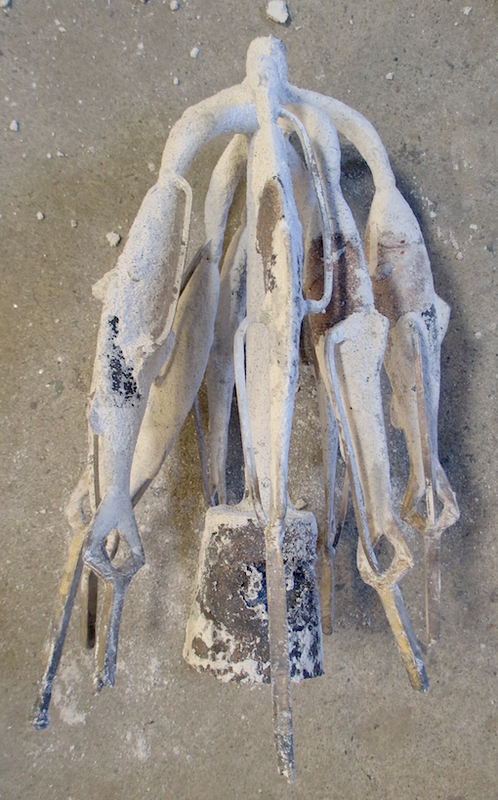| Finally back to the fish and curly bark project I wrote about in my blog entry for 4/22. After the 2 molds were poured and the castings broken out, I began the process of cleaning the investment off the bronze. Much of the investment material will drop off if you pound the pour cup with a heavy hammer or mallet, due to the vibrations. You can also use a piece of wood with an angled end and a brass wire brush to remove more stubborn areas. The final thin coating of material was cleaned off in the bead blaster (tiny glass beads are used instead of sand, so that the character of the metal surface texture is not destroyed). The next step was to cut off the pour cup and all of the metal gating. I used a angle grinder with a cutoff blade for the thicker pieces of gating, and then a dremel tool for the smaller ones. (I left both side posts on the fish. I would remove one after deciding where each fish would be positioned on the various bark strips.) Once all of the elements were separated, I chased each piece, removing any surface irregularities, and re-texturing surfaces where gating had been removed. Because the fish had had gates attached to the tip end of their faces, chasing process also involved re-making the mouths of the fish with a dremel cutting wheel. |
|
Chasing completed, I next had to determine how the fish were to be positioned on the strips. I cut 2 rows of evenly spaced holes in a 4"x24" piece of plywood, so that I could set up the bronze strips and determine how and where I wanted to place the individual fish. I knew I wanted them at different heights and angles, and on different sides of the strips. As I made my decisions, I marked where I would drill the fish post holes. After drilling the holes, I cut off the unneeded posts and re-surfaced to removal sites on the sides of the fish. Holes drilled, posts removed, I was able to set up the fish and get a feeling of how the finished piece would come together. (I made 8 fish and 8 strips, but decided that 7 and 7 worked better compositionally.) Now it's back to the foundry at MECA to get the fish welded in place and think about patinas and bases. Stay tuned!
0 Comments
* * * * * * * *
|
AuthorCynthia Smith, Maine artist, originally from Connecticut. Taught art at secondary level for 35 years, retired in 2004. Sculpts in bronze, wood, stone, clay & plaster. Her work can be seen at several mid-coast Maine galleries and shows. Archives
June 2023
|
















 RSS Feed
RSS Feed